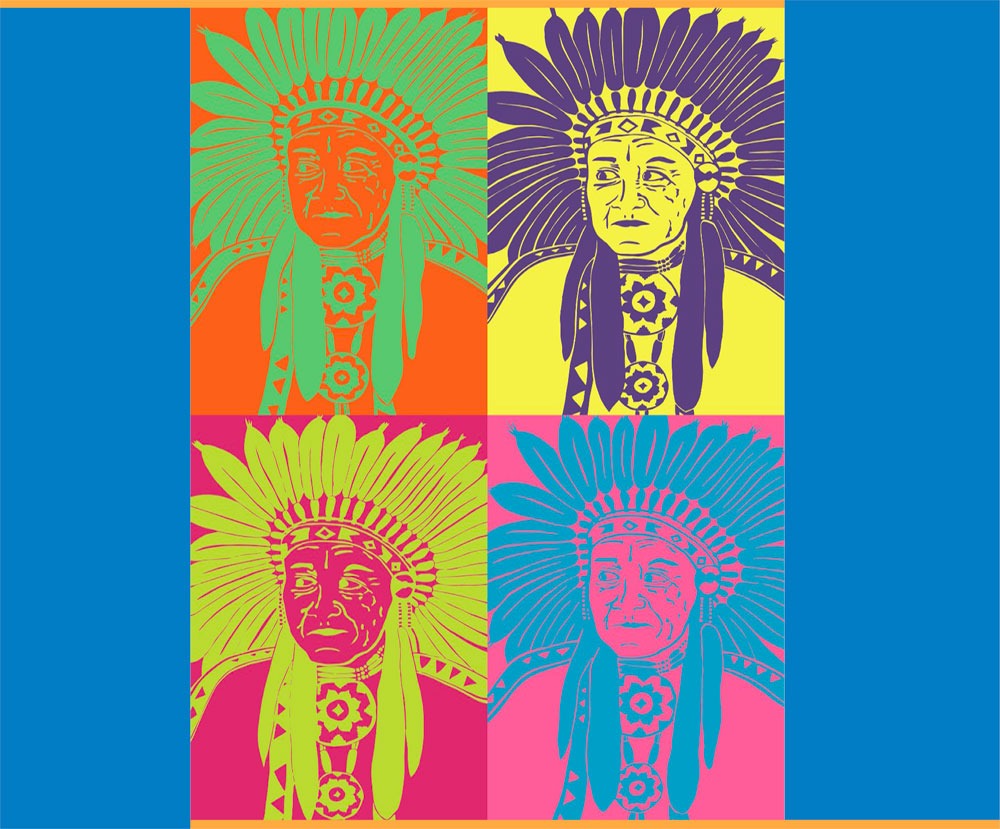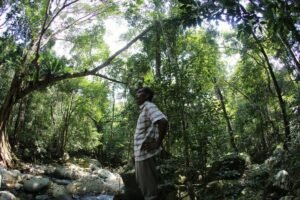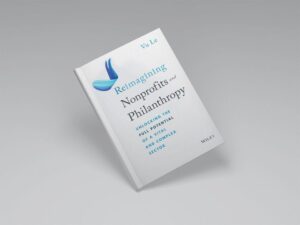
Frontline Solutions, in partnership with Melvin Consulting and First Nations Development Institute, is launching a new report entitled Searching for Inclusion in Philanthropy, some key findings of which are described in the article below.
Study after study confirms that philanthropy remains predominantly white. The Council on Foundations (COF) reports that over 75 percent of US foundation staff are white. According to the D5 Coalition, 92 percent of foundation CEOs, 84 percent of executive staff, and 87 percent of foundation boards are white. A key aspect of perpetuating white dominance in the sector starts at the beginning—the hiring process.
Researchers at First Nations Development Institute, Frontline Solutions, and Melvin Consulting examined hiring practices by interviewing and engaging with search firm representatives who play a key role in filling top leadership positions in private foundations. The full report can be found here.
In our report, we document the lack of Native American representation within private US foundations. Today, fewer than 35 Native people control giving portfolios or serve in key leadership roles at private foundations—nationwide. According to the COF report, as of 2015, “Individuals with American Indian or Alaskan Native heritage constituted .09 percent of administrative positions, .06 percent of executive positions, and .30 percent of professional positions.” The report adds that, “these proportions did not change appreciably between 2011 and 2015.”
The results are obvious. Without Native representation in foundations, Native communities continue to be invisible, excluded, and minimized by the giving practices and overall social agendas of foundations.
As communities across the US have pushed philanthropic institutions to be more diverse, equitable, and inclusive in all aspects of their operations—including hiring practices, board recruitment, and giving—these institutions have resisted. Consequently, meaningful measures of becoming more diverse, equitable or inclusive have been elusive. Folk who are Black, indigenous, and people of color (BIPOC) continue to be invisible within the hiring and board compositions of US foundations. Research has continually shown that foundation board and staff composition typically comes from insular and elitist (mostly coastal) networks.
The exclusion of BIPOC individuals from boards and staff causes foundations to miss out on their genius and contributions. But their exclusion also has a direct impact on philanthropic support, as existing (and typically white) networks often lack meaningful relationships with communities that have been affected by structural and systemic colonialism, racism, and discrimination. Thus, these communities remain invisible, excluded, and minimized in foundation giving. Recent research that has continued to document the exclusionary and inequitable funding practices for communities of color include the Race to Lead reports and Racial Equity and Philanthropy: Disparities in Funding for Leaders of Color Leave Impact on the Table by Echoing Green and Bridgespan, among others.
The same is certainly true in terms of representation of Native people within philanthropy. The absence of Native staff within US foundations has a direct impact on foundations’ relationships with Native communities (or lack of) and support of (or lack of support for) Native-led community change. Research shows that foundation support of Native-led community change is extremely small and volatile, declines in times of crisis, and takes years to rebound. In fact, less than a quarter of one percent of foundation dollars flow to Native-led organizations. To learn more about the historical and continued underinvestment of Native people and communities, see research by Native Americans in Philanthropy and First Nations Development Institute.
Why Are So Few Native Americans Employed at Private Foundations?
Much of what individuals in philanthropy (as well as the general public) know about Native Americans is based on misinformation, bias, and stereotypes. Consequently, when Native people are excluded from philanthropy, misinformation, stereotypes, and unchecked bias flourish and lead to marginal investment and inauthentic relationships with Native people and communities.
This widespread misinformation and overall lack of familiarity with Native communities often results in disparate treatment in the sector. We spoke with Native leaders who were recently subjected to discriminatory and insulting treatment by a well-known search firm that was hiring for a position within a foundation that was purportedly mission-focused on supporting the rights and opportunities of Indigenous peoples and communities. The search director from this white-led search firm (and not part of the search firms interviewed for the study) conducted interviews with Native candidates and took the opportunity to disparage their credentials, minimize their leadership qualities and experiences, and question the talent of the staff at candidate organizations—all the while claiming a level of self-expertise on Indigenous issues that these Native leaders tackle daily as part of their current positions.
This type of behavior too often remains unchecked as search firms are accountable only to their foundation clients. These firm directors continue to blaze a trail of disrespect with prospective Native candidates as they conduct searches for foundations that claim to be committed to advancing diversity, equity, and inclusion.
This example is not intended to portray all search firms in the same negative light, as some Native leaders we interviewed have had very good interactions with other search directors and firms. Moreover, our research documents that some firms do take seriously their role in growing the diverse pool of candidates for foundation hires. But this recent experience does raise serious questions about hiring practices that deserve further interrogation as we continue to push the sector to be more diverse, equitable, and inclusive.
The Role of Search Firms
Not every search firm is as guilty of blatant discrimination as the example cited above. But the story reminds us of the critical gatekeeper role search firms play in the foundation professional process. Furthermore, individuals do find their way to positions in philanthropy in a variety of ways—not just through search firm processes—but we must acknowledge the important role such firms play in recruitment and hiring for staff and some board placements.
Sign up for our free newsletters
Subscribe to NPQ's newsletters to have our top stories delivered directly to your inbox.
By signing up, you agree to our privacy policy and terms of use, and to receive messages from NPQ and our partners.
Thus, our research approach focused these firms and the role they play. We had hoped to include a Native-owned search firm in our study. However, we could not identify any firms working in the US with private foundation search placement experience.
All the individuals we interviewed were from firms that had a public-facing statement regarding their commitment to diversity, equity, and inclusion. Almost all the individuals from the firms we spoke with were admittedly on their own learning journey when it comes to diversity, equity, and inclusion. But all individuals were open and willing to share their perceptive and experiences as they relate to search processes, challenges they have encountered, and ways that they can improve their practice and make foundation hiring more diverse and inclusive. We are extremely grateful for their openness and partnership in the process.
Stop Placing Blame on “Pipeline Issues”—Unless You’re Stopping Pipelines
One common trope that we ran into regularly when conducting our surveys was the so-called “pipeline issue.” This trope, of course, does not solely affect Native Americans. Not long ago, Wells Fargo CEO Charles Scharf was reported by Reuters as saying that, “While it might sound like an excuse, the unfortunate reality is that there is a very limited pool of Black talent to recruit from.” This was his attempt to address the inability of the bank to hire more diverse staff.
Scharf’s comments reflect those of a long line of white leaders from different sectors who suggest that communities themselves do not produce the qualified and talented individuals needed to fill leadership roles in key leadership roles within the US workforce. The same is true in philanthropy.
Many of the search firms acknowledge that “pipeline” issues are commonly cited as a barrier to hiring. But often, arguing that pipeline issues affect hiring in fact places blame on already marginalized communities rather than investigating the ways in which hiring practices and processes work to exclude diverse candidates. And, for Native communities, blaming “pipelines” for the lack of hiring qualified Native candidates conjures up even more trauma, as Native communities have actual harmful physical pipelines that run through their communities and have to fight regularly to try to stop these pipelines from being built or to shut them down.
Representation, Data, Storytelling, and Pro-Tips
Representation matters when foundations and search firms engage in hiring. Search firm professionals acknowledge that having people of color on staff within search firms and also on foundation internal hiring committees matters. Having people of color authentically involved (and even leading searches) makes searches for diverse candidates more successful and leads to deeper connections and networks within diverse communities and better strategies for facilitating and maintaining trust in these communities. When trust is developed with talent pools, search firms are not seen as simply pillaging the networks and contacts of perspective candidates, and relationships move from transactional to transformational.
Search firm professionals also acknowledge a need to be able to provide quality data on the racial and ethnic demographics of past search placements. Still, they note that some search firms also count white women as part of their “diversity hire” numbers. To improve accuracy in reporting, true racial and ethnic demographics must be captured. Further, data must be disaggregated to fully convey how search firms recruit and place BIPOC candidates.
Our conversations with search leaders also reveal that firms with an organization-wide learning agenda are more likely to distribute their learnings broadly across firms rather than forcing single individuals or departments to shoulder the burden. Greater success in finding and placing diverse candidates is facilitated when firms include the following factors:
- Develop learning agendas to identify internal biases as a firm and in the client’s search approach.
- Challenge the perceptions and misperceptions of Native communities, specifically around relocation challenges, access to high-net-worth donor networks, and how tribal leadership experience is conveyed.
- Increase the use of storytelling to interpret the working histories and expertise of candidates to paint a more accurate picture of the candidate rather than merely focusing on outputs.
- Educate clients on onboarding practices that can support non-white candidates as they enter predominantly white organizations.
On the candidate side, interacting with a search firm is a mystifying and in many ways secretive process. Some search firms acknowledged this and also saw it as part of their obligation to provide helpful coaching for candidates throughout the search process—from recruitment to negotiations.
Beyond examining practices that are barriers to Native inclusion within hiring processes, Searching for Inclusion in Philanthropy also offers tips and resources for perspective candidates, foundations, hiring committees, and search firms. For example, our tips for foundations include the following:
- Learn to see and find value in non-traditional backgrounds, cultures, and work experiences.
- Stress the connection to mission alignment.
- Track goals, measure progress, and be transparent.
- Acknowledge and own the history of your foundation. Have honest conversations about the difficult relationship between philanthropy and Native communities.
- Develop an organizational commitment to understanding and practicing diversity. If you are going to bring on your first Native American staff member, never make it a one-and-done hire.
- Once Native people are hired, be sure to avoid tokenism and placing undue burdens on them. Do not make a Native staff member the poster child for all things Indian within your foundation.
There is, for sure, a long way to go before the above practices become the “common sense” of the philanthropic field. More encouragingly, we did find search firms that succeeded in placing Native Americans in foundation program officer and leadership positions. Those that did so succeeded because they integrated into their operations some key practices, including spending more time with candidates to “listen differently” and finding ways to help candidates communicate their achievements and skills. This latter item often required helping Native candidates translate their non-traditional or non-philanthropic working experiences into items that could be incorporated in résumés and therefore made visible to foundation hiring committees.
The road ahead may yet be long, but one thing is for certain, there is no lack of available talent or qualified Native candidates, only a gap in the way qualified candidates are recruited and presented throughout the process. This report highlights the issue of hiring and offers tips to improve the hiring process so that we can see more talented and qualified Native people working in philanthropy.
Jessica Barron, Ph.D., is a consultant with Frontline Solutions. Eileen Egan is a partner at Melvin Consulting PLLC. Raymond Foxworth is Vice President at First Nations Development Institute.











